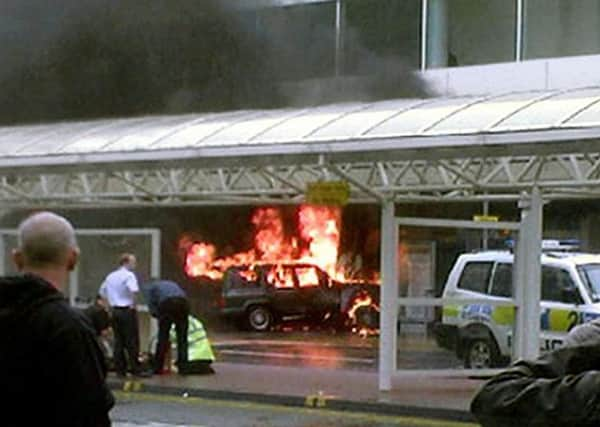Glasgow terror attack transformed flying forever


Initial shock at the unprecedented assault on a Scottish airport was swiftly followed by far-reaching measures that were copied across the globe.
Glasgow’s terminal re-opened just 24 hours after two men crashed a Jeep laden with gas canisters into its entrance doors at 3:15pm on 30 June 2007 – one of its busiest days of the year.
Advertisement
Hide AdAdvertisement
Hide AdHowever, the UK government’s Transport Security and Contingencies Directorate (Transec) said the attack “demonstrated not only the attractiveness of aviation as a target, but also the vulnerability of the landside areas”.
Kafeel Ahmed, one of the terrorists, died a month later from burns suffered after the car burst into flames.
The other, Bilal Abdulla, was jailed for at least 32 years.
In the aftermath, along with “fairly rapid running repairs” to damage around the terminal doors, vehicles were immediately banned from the vicinity of the building – a move copied at airports across the UK overnight.
As the Glasgow Airport development masterplan put it: “The terrorist attack led to wide-ranging changes regarding vehicle access to airports throughout the world.”
Police said had it not been for a concrete stanchion, the Jeep would have been able to enter the terminal.
Detective Superintendent David Swindle, who led the investigation into the attack, said: “You can never know how many, but there would have been fatalities.
“Also, if it had not been for the intervention of people at the scene, they might still have been able to cause harm.”
Advertisement
Hide AdAdvertisement
Hide AdAirport security improvements since the Glasgow attack have focused on making the sites unpromising targets, according to Gordon Dewar, who was Glasgow’s managing director in 2007.
However, he said that was being achieved while also ensuring security was not so overwhelming it was unbearable.
Mr Dewar, who is now chief executive of Edinburgh Airport, said: “We are trying to make airports a very unattractive target – you will be caught and might lose your life.” That included close monitoring of the terminal to spot suspicious people, and the deployment of explosive-monitoring devices.
Other measures include minimising concentrations of people “landside”, such as by keeping check-in queues short and moving passengers through security as soon as possible to the greater safety of the “airside” of the terminal – the “core asset”.
There is also blast protection to prevent debris from any potential explosion becoming shrapnel.
Mr Dewar said: “Aviation leads the way in trying to get the balance right between very high quality protection and it completely consuming the way we want to live our lives.
“We have clearly eliminated the risk of a vehicle being driven into the building – people should feel safe from that form of attack.”
However, he added: “You cannot have 100 per cent security, because airports are open to the public. Nothing’s foolproof.”
Advertisement
Hide AdAdvertisement
Hide AdSteel bollards now guard airport terminals to prevent another vehicle-based assault, with passengers switched to nearby drop-off areas instead.
The Glasgow incident, along with two failed car bomb attacks in London the previous day, also had a knock-on effect on railway station security.
Transec said it accelerated work to control vehicle access to stations. This led to the closure of car parks, drop-off areas and taxi ranks at Edinburgh Waverley and Glasgow Central.
The airport attack provided a further catalyst to security and safety measures, ten months after liquids were banned from passengers’ hand luggage after the discovery of a plot in August 2006.
There are still tight curbs on what passengers can carry with them onto aircraft, such as liquids only in 100ml or smaller containers.
Security has also been further tightened at Glasgow’s terminal with the addition of a second perimeter to provide an exclusion zone to protect people congregating outside.
This has been replicated elsewhere – Edinburgh Airport’s multi-storey car park forms part of its protective barrier.
Passengers at Glasgow Airport yesterday said they felt reassured rather than inconvenienced by the additional measures.
Advertisement
Hide AdAdvertisement
Hide AdOne said: “It makes you feel more secure with the bollards, it definitely does.”
Another said: “It’s for the greater good. I would rather walk the extra two minutes with more security there than be dropped off right at the door.”
Travellers were also unperturbed by the increased presence of armed police. One woman said: “I prefer them to be there to prevent it than not be there and it happen again.”